RIGHT/LEFT HAND CURVE
|
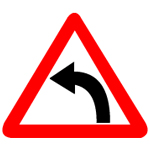 |
| This sign is used where the direction of alignment changes. The sign forewarns the driver to reduce the speed and proceed cautiously along the road. |
RIGHT/LEFT HAIR PIN BEND
|
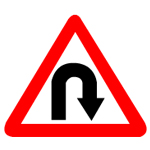 |
| This sign is used where the change in direction is so considerable that it amounts to reversal of direction. The symbol bends to right or left depending upon the road alignment. |
RIGHT/LEFT REVERSE BEND
|
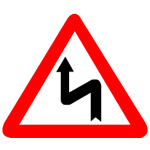 |
| This sign is used where the nature of the reverse bend is not obvious to approaching traffic and constitutes a hazard. If the first curve is to the right, a right reverse bend shall be used. If the first curve is to the left, a left reverse bend is used. |
NARROW BRIDGE
|
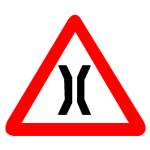 |
| This sign is erected on roads in advance of bridges where the clear width between the kerbs or wheel guards is less than normal width of carriageway. |
GAP IN MEDIAN
|
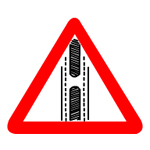 |
| This gap is installed ahead of a gap in the median of a divided carriageway, other than an intersection. |
NARROW ROAD
|
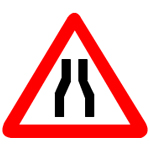 |
| This sign is normally found in rural areas where a sudden reduction in width of pavement causes a danger to traffic. |
ROAD WIDENS
|
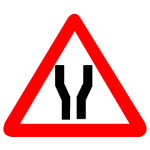 |
|
This sign is normally found in rural areas where a sudden widening of road causes a danger to traffic, such as, a two-lane road suddenly widening to a dual carriageway
|
CYCLE CROSSING
|
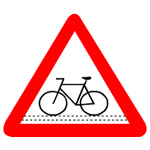 |
| This sign is erected in advance of all uncontrolled cycle crossings. |
PEDESTRIAN CROSSING
|
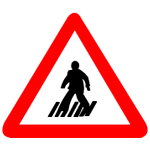 |
| This sign is erected in advance of both approaches to uncontrolled pedestrian crossings. |
SCHOOL AHEAD
|
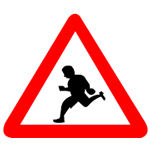 |
|
This sign is erected where school buildings or grounds are adjacent to the road where the traffic creates a hazard to children.
|
MEN AT WORK
|
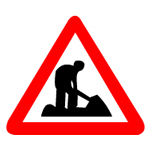 |
|
This sign is displayed only when men and machines are working on the road or adjacent to it or on overhead lines or poles. This sign is removed when the work is completed.
|
SIDE ROAD LEFT
|
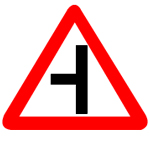 |
| This sign is displayed in advance of the side road intersections where a large volume of entering traffic together with restricted sight distance is likely to constitute a hazard. The driver is warned of the existence of a junction. |
SIDE ROAD RIGHT
|
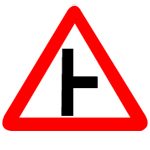 |
| This sign is displayed in advance of the side road intersections where a large volume of entering traffic together with restricted sight distance is likely to constitute a hazard. The driver is warned of the existence of a junction. |
Y-INTERSECTION
|
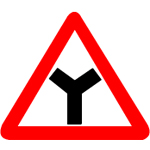 |
|
These signs are displayed on the approach to a bifurcation of any road. This sign warns of the existence of a junction and no other indication is given.
|
MAJOR ROAD
|
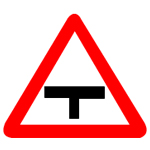 |
| These signs are displayed in advance of crossing with the major road, where a sufficiently large volume of traffic together with a sufficiently large volume of traffic together with restricted sight is likely to cause a hazard. |
STAGGERED INTERSECTION
|
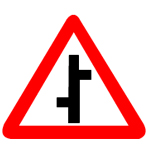 |
|
This sign is used to indicate junctions where the distance between two junctions is not more than 60 meters.
|
T INTERSECTION
|
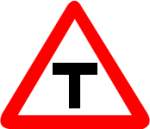 |
| This sign is displayed in advance of T-junctions where the nature of inter-section is not obvious to approaching traffic. This sign is used to warn the driver of the existence of a junction. |
ROUNDABOUT
|
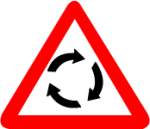 |
| This sign is used where it is necessary to indicate the approach to a roundabout. |
START OF DUAL CARRIAGEWAY
|
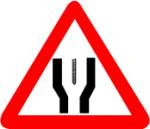 |
| This sign is displayed when a single carriageway ends into a dual carriageway. |
END OF DUAL CARRIAGEWAY
|
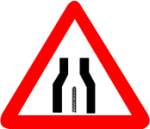 |
| his sign is displayed when a dual carriageway is ending and a single carriageway is starting. |
REDUCED CARRIAGEWAY
|
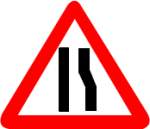 |
| These signs caution the driver of the reduction in the width of the carriageway ahead. This is displayed on undivided carriageways when some portion of the carriageway is closed or reduced for repairs. |
TWO WAY OPERATION
|
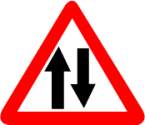 |
|
This sign is used to caution the driver of a changed pattern of traffic operation of the carriageway expected to carry traffic in one direction only.
|
CROSS ROAD
|
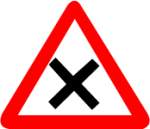 |
| This sign is displayed in advance of the cross road where a sufficiently large volume of crossing or entering traffic with restricted sight distance is likely to constitute a hazard. |
CATTLE
|
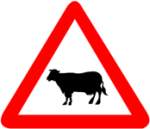 |
| This sign is used where there is danger due to farm animals or cattle crossing on the road. |
TRAFFIC DIVERSION ON DUAL CARRIAGEWAY
|
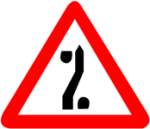 |
| This sign warns the driver of the diversion of traffic from one carriageway to the other. It is used on dual carriageway when one carriageway is closed. |
FALLING ROCKS
|
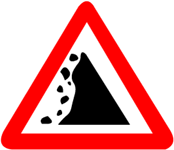 |
| This sign is used wherever rocks are liable to fall on the road seasonally or throughout the year. The symbol may be reversed to show the side from which rock fall is expected. |
FERRY
|
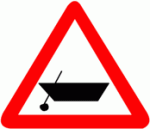 |
| This sign is used to warn the drivers about the existence of a ferry crossing across a river. |
LANE CLOSURE
|
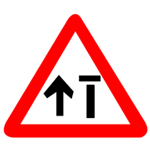 |
| This sign cautions the driver of the closure of a portion of the carriageway on multi-lane highways. |
BARRIER
|
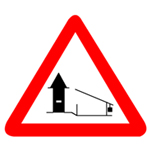 |
| This sign is erected in advance of a gate controlling entry into a road. A definition plate with words "SLOW BARRIER AHEAD" or "TOLL BARRIER AHEAD" is also displayed on the sign. |
LOOSE GRAVEL
|
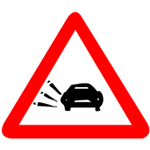 |
| This sign is used on section of a road on which gravel may be thrown up by fast moving vehicles. |
OVERHEAD CABLE
|
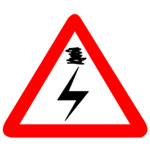 |
| This sign cautions driver of the presence of overhead power transmission lines. |
QUARY SIDE OR RIVER BANK
|
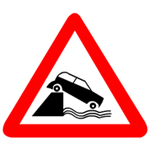 |
| This sign is used to caution the driver of the presence of water by the side of the road and the impending danger. |
ROUGH ROAD
|
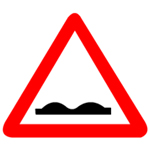 |
| This sign is posted where the road is rough and the drivers are required to slow down their vehicles for safe travel. |
RUNWAY
|
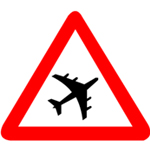 |
| This sign is used to warn the drivers of the presence of runway ahead and possible movement of the aircrafts. |
SERIES OF BENDS
|
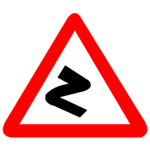 |
| This sign is used to installed to caution the driver of the presence of zigzag for a long distance over the section of road ahead. |
SLIPPERY ROAD
|
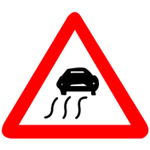 |
| This sign is used to warn that the section of the road ahead may be particularly slippery. |
SUDDEN SIDE WIND
|
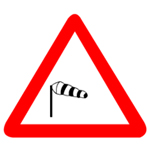 |
| This sign is used to caution the driver of the danger of side winds which endangers the lives of travelers. This sign is posted at places where such weather conditions exist. |
UNGUARDED RAILWAY CROSSING
|
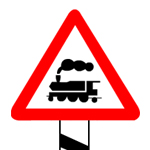 |
| This sign is used on the approaches of level crossings where there are no gates or other barriers. An advance warning sign (with two bars) is installed at a distance of 200 meters and second sign (with one bar) is installed near the crossing. |
GUARDED RAILWAY CROSSING
|
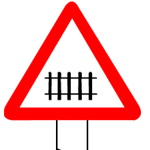 |
| This sign is used to warn traffic on the approaches to guarded railway crossing. An advance warning sign (with two bars) is installed at a distance of 200 meters and second sign (with one bar) is installed near the crossing. |
STEEP ASCENT
|
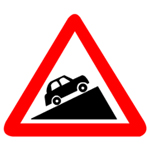 |
| This sign is displayed before a steep upgrade/downgrade that may constitute a hazard to traffic. A gradient of 10 per cent and above is considered steep gradient. |
STEEP DESCENT
|
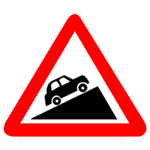 |
| This sign is displayed before a steep upgrade/downgrade that may constitute a hazard to traffic. A gradient of 10 per cent and above is considered steep gradient. |
RUMBLE STRIP
|
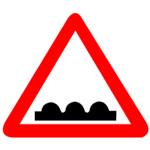 |
| This sign is installed in advance of the rumble strips provided on the road to control the speed of the vehicle. |
DANGEROUS DIP
|
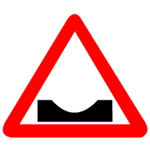 |
| This sign is used where a sharp dip in the profile of the road or a causeway is likely to cause considerable discomfort to traffic. |
SPEED BREAKER
|
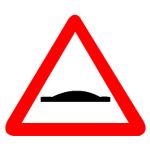 |
| This sign warns the drivers of the presence of a speed breaker. |